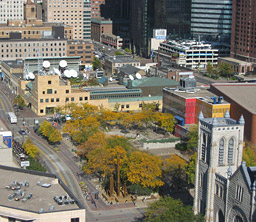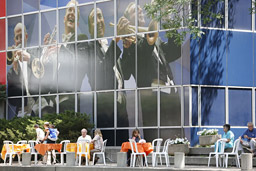
Nicollet Mall
Minneapolis, Minnesota
Peavey PlazaMinneapolis, Minnesota
history continued
The mall’s proposed terminus, however, was a fringe area of low-end hotels, marginal businesses, and surface parking lots. Continuing the urban renewal approach of the 1960s, the nine-block Loring Park Development District was established in the early 1970s, annihilating most of the existing buildings to create an open field for new development. A greenway would connect the mall to Loring Park, the original Central Park of the city’s renowned park system.
M. Paul Friedberg, a young New York landscape architect, was hired to delineate fourteen development sites on the cleared land and to design the greenway and the mall plaza.
The plaza was to be the “front yard” for the new concert hall for the Minnesota Orchestra, another sign of the city’s renaissance. After considering a number of locations, the Minnesota Orchestral Association had agreed to share a city block with the plaza. The city council approved the construction of Orchestra Hall in May 1973, and the official groundbreaking followed in June.
The plaza’s progress was slowed by a common roadblock—lack of money. This hurdle was lowered in October 1973 when the Peavey Company, a local agribusiness, donated $600,000 towards the cost of the plaza. In return, the plaza was given the company’s name.

